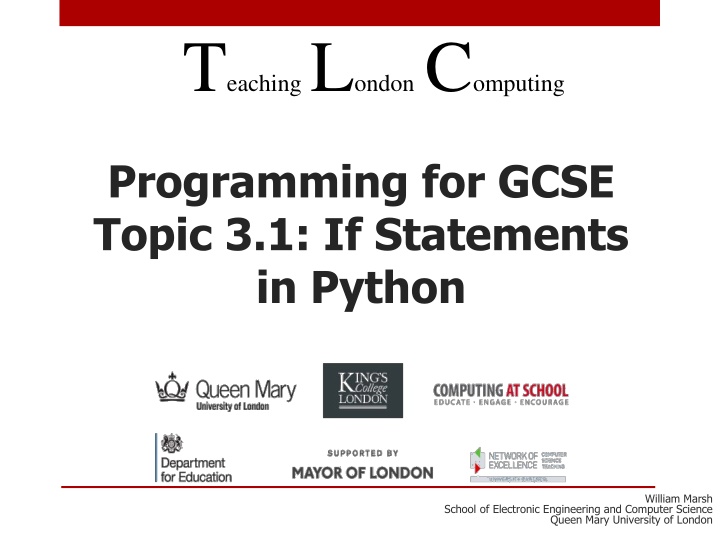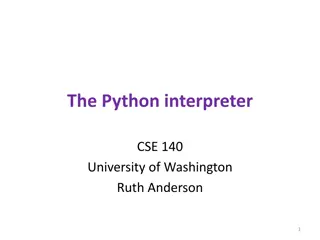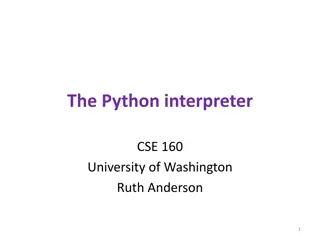Introduction to If Statements in Python for GCSE Students
Delve into the world of programming with If Statements in Python. Learn the basics, visualizations, and practical applications through examples. Understand the syntax, conditions, and flow control for creating decision-making programs. Explore comparisons, boolean expressions, and more complex If statements to enhance your coding skills.
Download Presentation

Please find below an Image/Link to download the presentation.
The content on the website is provided AS IS for your information and personal use only. It may not be sold, licensed, or shared on other websites without obtaining consent from the author.If you encounter any issues during the download, it is possible that the publisher has removed the file from their server.
You are allowed to download the files provided on this website for personal or commercial use, subject to the condition that they are used lawfully. All files are the property of their respective owners.
The content on the website is provided AS IS for your information and personal use only. It may not be sold, licensed, or shared on other websites without obtaining consent from the author.
E N D
Presentation Transcript
TeachingLondon Computing Programming for GCSE Topic 3.1: If Statements in Python William Marsh School of Electronic Engineering and Computer Science Queen Mary University of London
Aims If statement basics Visualising If Language Boxes Scratch Comparisons Boolean expressions More complex If statements
Simple If Statement Change the statements in a program age = int(input("How old?")) if age > 21: print("Cool! A grown up") Key word Condition : indentation
VISUALISINGIF Indentation versus brackets
Boxes An 'if' statement has an inside if condition A: Only enter the box when 'A'
Boxes An 'if' statement has an inside if condition A: Only enter this box when 'A' else: Only enter this box when not 'A'
If in Scratch Scratch blocks make the inside idea obvious Conditio n Inside Conditio n Inside condition true Inside condition false
Other Languages Java uses ( ) condition in brackets; no colon '{' start of box '}' end of box Pascal THEN instead of the colon BEGIN start of box END end of box
'If' Language Many instructions have 'if' language Do not use this service if you are travelling within the next four weeks, or if you are applying from outside the UK if travelling in next 4 weeks: print("Do not use this service") elif applying from outside UK: print("Do not use this service") else: print("Ok; use this service")
COMPARISONS True and false expression used in 'if'
True and False Expressions Comparisons Result can be 'True' or 'False' Operator x > y x < y x == y x != y x <= y x >= y Meaning x is greater than y x is less than y x is equals to y x is NOT equal to y x is less than or equal to y x is greater than or equal to y
Examples What are the values of the following? Expression True or False? 10 > 5 2 + 3 < 10 10 != 11 10 <= 10 10 >= 11
Comparison of Strings Comparison operators work for strings Look at the following examples Using ASCII ordering, letter by letter >>> "David" < "David Cameron" True >>> "Dave" < "David" True >>> "Tom" < "Thomas" False >>> "Bill" < "William" True >>> "AAA" < "AAB" True >>> "AAA" < "aaa" True >>> "aaa" < "AAA" False
'=' and '==' Do not confuse Assignment Operator = Set variable to value (of expression) Equality Operator == Compare two expressions
MORE COMPLEX CONDITIONAL STATEMENTS
Else and Else If 'If' statement with an alternative if condition: statement 1 when condition true else: statement 2 when condition false if condition A: statement 1 when condition A true elif condition B: statement 2 when A false and B true else: statement 3 when both A and B false
Compare these programs: age = input("How old are you?") if age < 22: print("Ah, youth!") if age >= 22: print("Cool! A grown up") age = input("How old are you?") if age < 22: print("Ah, youth!") else: print("Cool! A grown up") Equivalent
Teaching Issue Strong understanding of statements within statements Needed for loops too Only 'if' and 'if else' are essential Boolean expression: true and false as values
Summary 'If' allows statements in the program to vary Comparison operator create 'conditions' (also called 'boolean expressions') Python uses 'indentation' to inside the 'if' from outside 'Inside' versus 'outside' essential for next topic: loops

 undefined
undefined



























